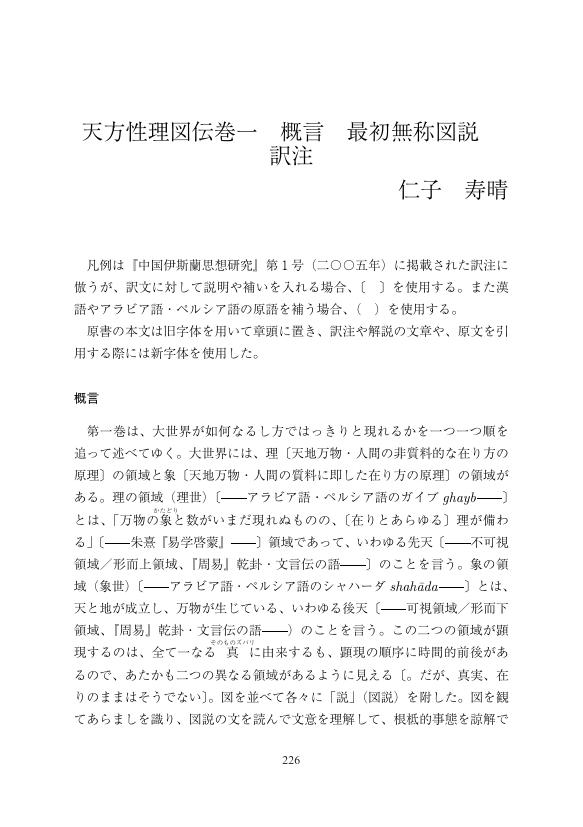4 0 0 0 OA イブン・スィーナー著『治癒』形而上学訳註 (第一巻第三章)
- 著者
- 小林 春夫 仁子 寿晴 加藤 瑞絵 倉澤 理
- 出版者
- 早稲田大学イスラーム地域研究機構
- 雑誌
- イスラーム地域研究ジャーナル (ISSN:1883597X)
- 巻号頁・発行日
- vol.5, pp.103-136, 2013-03-31
3 0 0 0 OA 天方性理図伝巻一 概言 最初無称図説 訳注
- 著者
- 仁子 寿晴
- 出版者
- 日本大学文理学部中国語中国文化学科
- 雑誌
- 中国語中国文化 (ISSN:02882604)
- 巻号頁・発行日
- vol.2020, no.17, pp.226-282, 2020 (Released:2020-05-11)
3 0 0 0 OA イブン・スィーナー著『治癒』形而上学訳註(第一巻第一章および第二章)
- 著者
- 小林 春夫 仁子 寿晴 加藤 瑞絵 倉澤 理
- 出版者
- 早稲田大学イスラーム地域研究機構
- 雑誌
- イスラーム地域研究ジャーナル (ISSN:1883597X)
- 巻号頁・発行日
- vol.3, pp.73-117, 2011-03-31
3 0 0 0 OA 環インド洋地域における宗教復興・テクノロジー・生命倫理
2 0 0 0 OA 哲学探究における数学 ファーラービーを哲学者として評価するための視座
- 著者
- 仁子 寿晴
- 出版者
- 一般社団法人 日本オリエント学会
- 雑誌
- オリエント (ISSN:00305219)
- 巻号頁・発行日
- vol.47, no.2, pp.1-19, 2004 (Released:2010-03-12)
The purpose of this article is a reinterpretation of Farabi's philosophy. Several difficult questions have arisen concerning Farabi's Trilogy, which consists of Tahsil al-Sa'ada, Falsafat Aflatun and Falsafat Aristutalis, one of which is how to understand the relationship among the three works. But in view of the general theme of the three works, i. e. investigation (fahs), and on comparing them with another investigative work, Kitab al-Huruf, we can see how Tahsil al-Sa'ada relates to the other two works.In the course of this examination, we must, at the start, solve the difficult question, how to interpret Farabi's assertion: ‘philosophy was completed with Aristotle’, which appears in two places (one in Tahsil al-Sa'ada, and the other in Kitab al-Huruf). If we take this assertion, it would mean that Farabi made no contribution to philosophy- he was only a transmitter, not a true philospher. However by considering Farabi's thought on the history of mathematics and the relation between mathematics and philosophy (especially logic), this phrase can be interpreted with subtle shade. (1) It is safe to say that in the age of Plato and Aristotle, as far as Farabi thought, mathematics was not fully developed, and so he could not really have believed that philosophy had been completed, for it seems that he thought mathematics and philosophy go hand in hand. (2) What he called into question when he discussed mathematics was not substantial matters or mathematical problems, but methodology. So we infer that his treatment of philosophy too is about methodology.This line of thought can show us the process of his introducing a mathematical methodology to his philosophy in the Trilogy. Now we can see how he describes in Tahsil al-Sa'ada the way his own philosophical investigation differs from that of Plato or Aristotle as seen in Falsafat Aflatun or Falsafat Aristutalis. Mathematical methodology has affected on Farabi's philosophy in various ways. This paper suggests some aspects of this effect, for example, we describe how it works in metaphysics and politics.This article cannot follow all the consequences of this thought, so it remains only preliminary research, but this step, I trust, is an important one for our understanding of Farabi's philosophy, especially of how he was a ‘true philosopher’.
1 0 0 0 OA イブン・スィーナー『治癒の書』に関する比較思想史的研究
1 0 0 0 OA オスマン朝期イスラーム思想研究-中世イスラーム思想の全体的解明を目指して
本研究は、これまでほとんど研究されてこなかったオスマン朝期イスラーム思想を解明することを目指した。3年間にわたる共同研究により、スーフィズム、神学、論理学、歴史学、政治思想、近代思想の各分野を概説する書籍を編集し、刊行した。『オスマン朝思想文化研究』と題された本書は、上記各学問分野の概観と代表的思想家の説明に加え、その著作を対訳の形で含んでいる。ほかに、オスマン朝期イスラーム思想にとって中核となるスーフィズムについて、イブン・アラビー学派の文献目録、スーフィズム関連用語集などを作成・刊行した。
1 0 0 0 IR 原典研究 イブン・スィーナー著『治癒』形而上学訳註(第一巻第一章および第二章)
- 著者
- IbnSina 小林 春夫 仁子 寿晴
- 出版者
- 早稲田大学イスラーム地域研究機構
- 雑誌
- イスラーム地域研究ジャーナル (ISSN:1883597X)
- 巻号頁・発行日
- vol.3, pp.73-117, 2011
